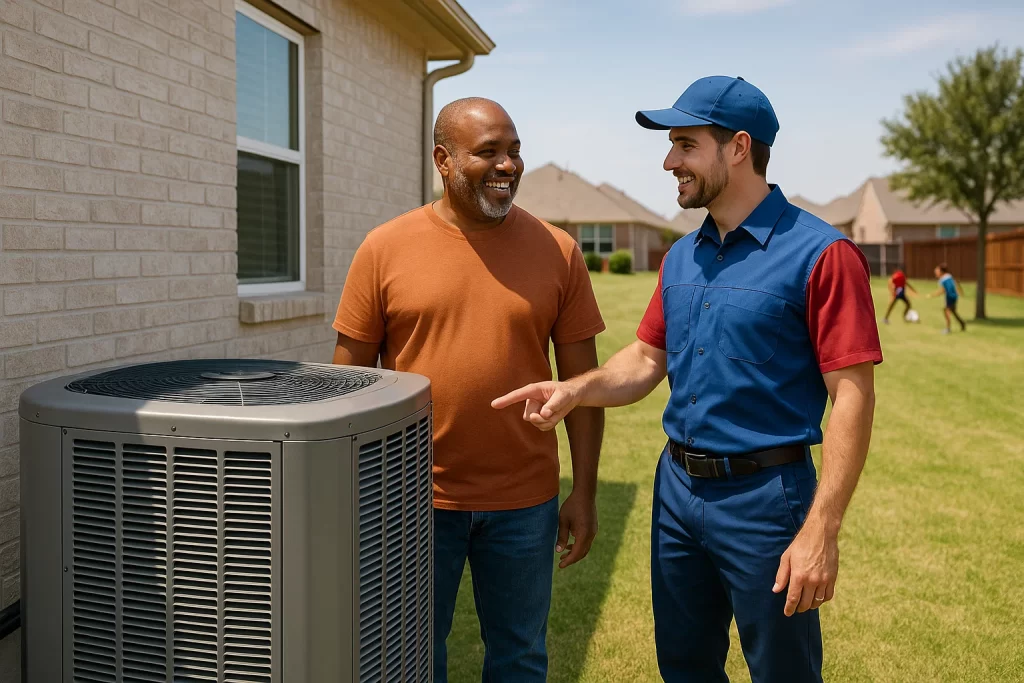As Texas continues to experience increasingly extreme weather conditions—scorching summers, surprise winter freezes, and everything in between—homeowners are looking for smarter, more efficient ways to manage indoor comfort. One of the most effective solutions on the market today is the heat pump in Wylie, TX. Often misunderstood or overlooked, heat pumps offer both heating and cooling in a single system, and their energy efficiency makes them a particularly wise investment for Texas homes.
How Much Does Heat Pump Installation Cost?
Heat pump installation typically costs between $3,000 and $8,000, depending on the system size, energy efficiency rating, and whether it’s a ducted or ductless setup. Ductless heat pumps may have higher per-unit costs but avoid ductwork expenses. Professional installers assess home layout, perform load calculations, and ensure proper sizing for efficient performance.

What Is a Heat Pump?
A heat pump is a versatile HVAC system that transfers heat rather than generating it. In cooling mode, it works much like a traditional air conditioner: it extracts heat from inside your home and releases it outdoors. In heating mode, the process reverses—drawing heat from the outside air (even when it’s cold) and bringing it inside.
Contrary to what you might think, there’s still heat in the air even when it’s chilly outside. Heat pumps use a refrigeration cycle, comprised of a compressor, expansion valve, and coils inside your HVAC system, to move this heat efficiently.
Why Are Heat Pumps So Efficient?
Heat pumps are incredibly efficient because they don’t burn fuel to create heat—they simply move it. This process can be up to three times more efficient than traditional electric or gas heating systems. For cooling, their operation is on par with high-efficiency central air conditioners, but their advantage shines in heating, especially in mild to moderate climates like much of Texas. This performance makes them a reliable alternative to traditional central AC systems in many homes.
Advanced models also include inverter technology, which allows the system to adjust its output dynamically instead of operating at full blast all the time. This results in more consistent indoor temperatures, quieter operation, and reduced energy costs year-round.
Benefits for Texas Homeowners
For Texans, the dual-purpose nature of a heat pump is particularly appealing. Summers can push temperatures above 100°F, and a heat pump provides powerful, reliable cooling. At the same time, the system can easily handle the occasional cold snaps without needing a separate furnace.
Additionally, Texas has a relatively mild winter climate in most areas, making it an ideal environment for air-source heat pumps to perform efficiently year-round. With electricity costs rising and homeowners increasingly interested in eco-friendly technologies, heat pumps offer a path toward reducing energy costs in Texas.
Modern heat pumps are also eligible for federal tax incentives and rebates, including those under the Inflation Reduction Act, which can dramatically offset installation costs, making the upgrade even more attractive financially.
Professional Installation Matters
To maximize the performance and lifespan of a heat pump system, professional installation is essential. Proper sizing, ductwork evaluation, and airflow balancing are critical factors that impact system efficiency. A licensed HVAC contractor will ensure your heat pump is tailored to your home’s HVAC needs.
Heat pumps are no longer just a fringe option—they’re becoming the go-to solution for energy-conscious homeowners. For Texans seeking comfort, efficiency, and long-term savings, upgrading to a heat pump can be a game-changer. With fewer breakdowns than standard AC units and professional installation, a heat pump can keep your home comfortable through every Texas season while cutting energy costs year after year.
Frequently Asked Questions
Question: What exactly is a heat pump, and how does it differ from a traditional air conditioner?
Answer: A heat pump moves heat instead of generating it. In cooling mode it works just like an air conditioner, extracting indoor heat and expelling it outside. But in heating mode it reverses the process, pulling heat from outdoor air and bringing it inside. The key difference is its dual functionality.
Question: Why are heat pumps considered more efficient, especially in places like Texas?
Answer: Heat pumps are efficient because they don’t burn fuel, they transfer heat. This can yield up to three times the efficiency of electric or gas heating. In mild winter climates, such as parts of Texas, their heating performance is quite favorable.
Question: Are heat pumps suitable for the extreme summer heat in Texas?
Answer: Yes. In cooling mode, heat pumps operate on par with high-efficiency central air conditioners. They’re well suited for handling hot Texas summers and can also handle occasional cold snaps without needing a separate furnace.
Question: What are the drawbacks or challenges of installing a heat pump in a Texas home?
Answer: The main challenges are higher upfront costs, the need for proper sizing and installation, and reduced heating performance in extremely cold spells. Also, because heat pumps run year round, both heating and cooling, component wear may be greater versus a cooling only system.
Question: Can Texas homeowners get financial incentives for installing a heat pump?
Answer: Yes. Modern heat pumps may qualify for federal incentives or rebates, for example under the Inflation Reduction Act, which can substantially offset the installation cost and improve the return on investment.
Schedule a heat pump assessment with Mr. Air Repair today. Family serving family!
